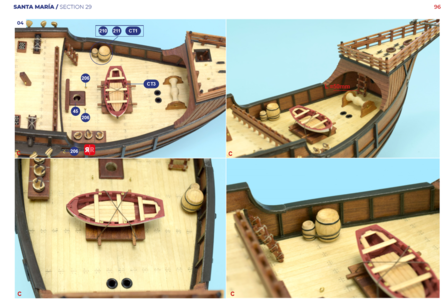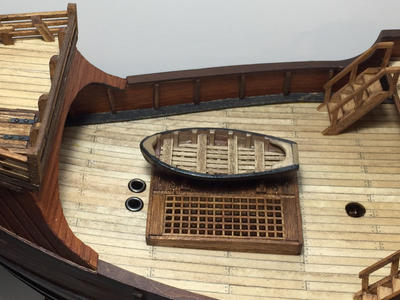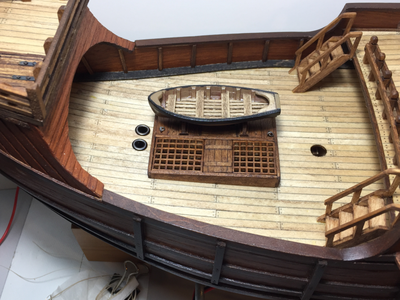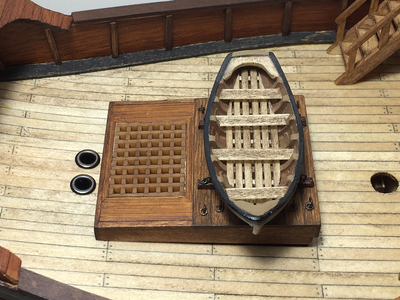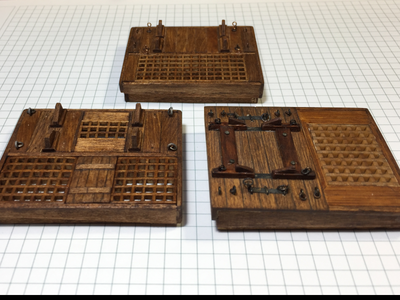-
LUCZORAMA SHIPWRECK SCAVENGER HUNT GIVEAWAY. 4 Weeks of Fun • 1 Legendary Prize ((OcCre’s Fram Ship)) • Global Crew Welcome!
**VIEW THREAD HERE**
You are using an out of date browser. It may not display this or other websites correctly.
You should upgrade or use an alternative browser.
You should upgrade or use an alternative browser.
Need a bit of advice - I got a bit confused by enthusiasm
Your right I guess it'll be either 1 or 2. Thank you for the compliment.Though #1 is perfectly fine, I like #2. There's no research to back that up, just my gut. As a side note, it's all very nice, I think she's a great ship, well done.
- Joined
- Dec 14, 2021
- Messages
- 276
- Points
- 168

I like No.2 the most. The 'trapdoor' adds a bit of mystery. All three are beautifully made by the way. What scale is this?
My vote is for #2. Although all three versions are nicely done.
And here’s another vote for #2. more detail with different textures
I like 1 or 2.
I will vote for #2
I like them all! Well done! Make three ships?
In my opinion option one is more in line with typical hatch covers and ship’s boat structures of the period. Anyway…I like number one…
Interesting how many different SM plans are out there; just building one SM model that has a hatch in the same area and my boat will be sitting on top of it.. But in this case i will go for #2 if the poll is still open 
Cheers
Cheers
1. #3. I can think of a dozen problems with this configuration (most of them have to do with sail handling and with deck management in heavy weather). Therefore for me, #3 is out.Made three different version of my version of the Santa Maria Hold. Before carrying on and completing them and then using only one on the eventually finished model. Could I please have an opinion as to which one looks preferable. Thank you.
View attachment 359317
View attachment 359318
View attachment 359319
View attachment 359320
2. Number two is better. But, the main purpose and function of the grating is to let air into the lower decks. I am not quite sure what the purpose would be in eliminating one-third of the grating and installing a garden fence gate in its' place (especially since you end up with three constructs when the job could be done just as well with two - one fence gate and one grating). Also, there is a 'standard' for deck grates and covers that has planks'
running parallel to the keel or perpendicular to the keel (usually not both) depending upon how the frames, beams and carlings are structured. . There is also a lot of woodwork that supports the ends of the planks in gratings and like structures. There would probably be no supporting structures for the end of the solid boards (unless, of course, you wanted to spend a lot of time energy and money to build totally non-standard decks for no practical gain other than just for the 'hell-of-it'). Also consider that the owner paying the bill would fire you on the spot in a hot second if he observed that the ships chief constructor had absolutely no idea how to build a ship to an almost 'standard' design that had proven itself over a period of about 2,000 years.
3. Therefore, I vote for fir #3 (even though it has problems that would have eliminated it as acceptable at the time) . Number three still has the 'fence gate boards' running in the wrong direction, but it is the best of the three. There is also one other problem, The two supports for the boat would have been at the ends of the hatch coverings and they would have rested on the deck (which is built strong enough to support the boat) and not on the hatch coverings (which would not be strong enough to support the boat). The first heavy seas will probably send the boat directly into the bilge. If you made this change, you could also position the boat along the centerline of the ship, which actually would have been where it would have been positioned. With tthis configuration you can remove the hatch covering planks, access the below deck areas and conduct the ships work with the least amount of unnecessary disruption to the ship's routine. I really think you should make a #4.
Made three different version of my version of the Santa Maria Hold. Before carrying on and completing them and then using only one on the eventually finished model. Could I please have an opinion as to which one looks preferable. Thank you.
View attachment 359317
View attachment 359318
View attachment 359319
View attachment 359320
Last edited:
Very much appreciate the compliment, Thank you. This is the Artesania Latina "Santa Maria' 1/65 scale.I like No.2 the most. The 'trapdoor' adds a bit of mystery. All three are beautifully made by the way. What scale is this?
I like them all! Well done! Make three ships?
 If only I had the time and skills but good suggestion.
If only I had the time and skills but good suggestion.#3 sits in the direction illustrated in the assembly photos. I get confused being new to ship modelling.I would say 1 or 2. 3 doesn’t look right. Maybe because it’s not streamlined with the ship?
Well I did ask for opinions and it appears I certainly got yours for which I am truly thankful and appreciative. Allow me to reply as follows;1. #3. I can think of a dozen problems with this configuration (most of them have to do with sail handling and with deck management in heavy weather). Therefore for me, #3 is out.
2. Number two is better. But, the main purpose and function of the grating is to let air into the lower decks. I am not quite sure what the purpose would be in eliminating one-third of the grating and installing a garden fence gate in its' place (especially since you end up with three constructs when the job could be done just as well with two - one fence gate and one grating). Also, there is a 'standard' for deck grates and covers that has planks'
running parallel to the keel or perpendicular to the keel (usually not both) depending upon how the frames, beams and carlings are structured. . There is also a lot of woodwork that supports the ends of the planks in gratings and like structures. There would probably be no supporting structures for the end of the solid boards (unless, of course, you wanted to spend a lot of time energy and money to build totally non-standard decks for no practical gain other than just for the 'hell-of-it'). Also consider that the owner paying the bill would fire you on the spot in a hot second if he observed that the ships chief constructor had absolutely no idea how to build a ship to an almost 'standard' design that had proven itself over a period of about 2,000 years.
3. Therefore, I vote for fir #3 (even though it has problems that would have eliminated it as acceptable at the time) . Number three still has the 'fence gate boards' running in the wrong direction, but it is the best of the three. There is also one other problem, The two supports for the boat would have been at the ends of the hatch coverings and they would have rested on the deck (which is built strong enough to support the boat) and not on the hatch coverings (which would not be strong enough to support the boat). The first heavy seas will probably send the boat directly into the bilge. If you made this change, you could also position the boat along the centerline of the ship, which actually would have been where it would have been positioned. With tthis configuration you can remove the hatch covering planks, access the below deck areas and conduct the ships work with the least amount of unnecessary disruption to the ship's routine. I really think you should make a #4.
1. #3. I can think of a dozen problems with this configuration (most of them have to do with sail handling and with deck management in heavy weather). Therefore for me, #3 is out.
#3 is based on the original as per the Instruction photos that accompanied the AL Santa Maria kit. Being new to modelling I follow the instructions where possible be they right or possibly wrong.
2. Number two is better. But, the main purpose and function of the grating is to let air into the lower decks. I am not quite sure what the purpose would be in eliminating one-third of the grating and installing a garden fence gate in its' place (especially since you end up with three constructs when the job could be done just as well with two - one fence gate and one grating). Also, there is a 'standard' for deck grates and covers that has planks'
running parallel to the keel or perpendicular to the keel (usually not both) depending upon how the frames, beams and carlings are structured. . There is also a lot of woodwork that supports the ends of the planks in gratings and like structures. There would probably be no supporting structures for the end of the solid boards (unless, of course, you wanted to spend a lot of time energy and money to build totally non-standard decks for no practical gain other than just for the 'hell-of-it'). Also consider that the owner paying the bill would fire you on the spot in a hot second if he observed that the ships chief constructor had absolutely no idea how to build a ship to an almost 'standard' design that had proven itself over a period of about 2,000 years.
2/ I’m not sure what you mean by ‘fence gate’ because many wooden hatches are strengthened in a similar manner with battens be they on top or underneath the planking.
You mention an almost standard design proven over a period of about 2,000 years yet In all publications referring to or relating to the Columbus Ships state that drawings are based on interpretations of what is alleged to be factual. These interpretations differ greatly depending of who the author is and from what evidence conclusions were drawn from.
There is no documented evidence, actual plans, drawings etc of this Nau and the accompaning caravelles Nina/Pinta, so I cannot understand how your ‘Standard design” comes into play regarding these ships. Everything is based on assuptions including those replicas claimed to be built according to the originals.
I doubt very much if Mi Tio Juan would have fired me on the spot because Shipwrights were very few and far between. They didn’t even work to any given plan just built as they went along mostly to protect their construction secrets and work methods. There was no standard to build to.
The Grate standards you refer to are they from the 1490’s era or later periods such as used by Britain, France and Holland?.
Why did I divide and seperate the grates etc? Simply because I struggled to make and assemble them hence used those that were or appeared to be pretty good for my limited skills. Note #3 is made from Bamboo skewers purchased at the local $2 shop.
3. Therefore, I vote for fir #3 (even though it has problems that would have eliminated it as acceptable at the time) . Number three still has the 'fence gate boards' running in the wrong direction, but it is the best of the three. There is also one other problem, The two supports for the boat would have been at the ends of the hatch coverings and they would have rested on the deck (which is built strong enough to support the boat) and not on the hatch coverings (which would not be strong enough to support the boat).
The first heavy seas will probably send the boat directly into the bilge. If you made this change, you could also position the boat along the centerline of the ship, which actually would have been where it would have been positioned. With tthis configuration you can remove the hatch covering planks, access the below deck areas and conduct the ships work with the least amount of unnecessary disruption to the ship's routine. I really think you should make a #4.
#3 is based on the AL instructions as can be seen on the photo below.
Limited as I am on knowledge of ships n boats from the Columbus era I surmise that when in port loading/unloading cargo the row boat would have been off-loaded and tied alongside thereby allowing the hold to be fully opened to received or off load barrels of cargo etc.
Having said all that I thank you very much for your opinion and input. It has been very much appreciated. Cheers Franco (ConsNZ)
